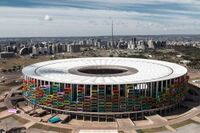VoyCom Arena: Difference between revisions
No edit summary |
No edit summary |
||
| (4 intermediate revisions by one other user not shown) | |||
| Line 13: | Line 13: | ||
| built = 2019 | | built = 2019 | ||
| opened = <!-- {{Start date|2019|03|21}} --> | | opened = <!-- {{Start date|2019|03|21}} --> | ||
| renovated = | | renovated = 2020 | ||
| expanded = | | expanded = | ||
| closed = | | closed = 2022 | ||
| demolished = | | demolished = 2022 | ||
| owner = VoyCom | | owner = [[VoyCom]] | ||
| operator = | | operator = | ||
| surface = Grass | | surface = Grass | ||
| Line 34: | Line 34: | ||
| acreage = | | acreage = | ||
| volume = | | volume = | ||
| tenants = [[Thracistan national football team]]<br>[[Petmut | | tenants = [[Thracistan national football team]]<br>[[Petmut FC]] | ||
| embedded = | | embedded = | ||
| website = | | website = | ||
}} | }} | ||
'''Voycom Arena''' | '''Voycom Arena''' was a [[wikipedia:association football|football]] [[wikipedia:stadium|stadium]] in [[Kadim]], Thracistan, and is the home of football in [[Petmut FC]] . The stadium was badly damaged during the Civil War, after a long renovation it was reopened as an Olympic village. On the exterior of the stadium, there are detachable hotel rooms that can accommodate people, these can host people on a half-row match day when athletes can stay. | ||
Within the scope of the Operation Gama project, which was started in {{AN|1706}}, the structures that would no longer belong to the [[Kadim]] began to be demolished one by one. This includes [[Thracistan]]'s ministry buildings, state palace, Thraci company buildings and sports facilities. [[VoyCom]] company moved to [[Izmir]] and the sponsorship agreement for the stadium has been completed. The stadium was closed after VoyCom ended its sponsorship. Worn seats of the VoyCom Arena were dismantled and donated to the sports facilities in the new territory of [[Çakaristan]], after which the athletics track, football turf, scoreboard, roof, locker room and restaurant furnishings and steps were dismantled and sent to the city of Anzo. The remaining skeletal structure was abandoned and rotted from years of disrepair. Finally, in {{AN|1710}}, action was taken for Demolition. After the demolition, a forest area and a zoo would be built in its place. | |||
[[Category:Stadiums]] | [[Category:Stadiums]] | ||
Latest revision as of 20:02, 13 May 2024
| VoyCom Arena | |
 | |
| Location | Kadim, Thracistan |
|---|---|
| Broke ground | 2019 |
| Built | 2019 |
| Renovated | 2020 |
| Closed | 2022 |
| Demolished | 2022 |
| Owner | VoyCom |
| Surface | Grass |
| Scoreboard | Two |
| Architect | Aslanbekir Architects |
| Project manager | Cemal Yılmaz |
| Capacity | 45,207 |
| Field dimensions | 110x69m |
| Tenants | |
|
Thracistan national football team Petmut FC | |
Voycom Arena was a football stadium in Kadim, Thracistan, and is the home of football in Petmut FC . The stadium was badly damaged during the Civil War, after a long renovation it was reopened as an Olympic village. On the exterior of the stadium, there are detachable hotel rooms that can accommodate people, these can host people on a half-row match day when athletes can stay.
Within the scope of the Operation Gama project, which was started in 1706 AN, the structures that would no longer belong to the Kadim began to be demolished one by one. This includes Thracistan's ministry buildings, state palace, Thraci company buildings and sports facilities. VoyCom company moved to Izmir and the sponsorship agreement for the stadium has been completed. The stadium was closed after VoyCom ended its sponsorship. Worn seats of the VoyCom Arena were dismantled and donated to the sports facilities in the new territory of Çakaristan, after which the athletics track, football turf, scoreboard, roof, locker room and restaurant furnishings and steps were dismantled and sent to the city of Anzo. The remaining skeletal structure was abandoned and rotted from years of disrepair. Finally, in 1710 AN, action was taken for Demolition. After the demolition, a forest area and a zoo would be built in its place.